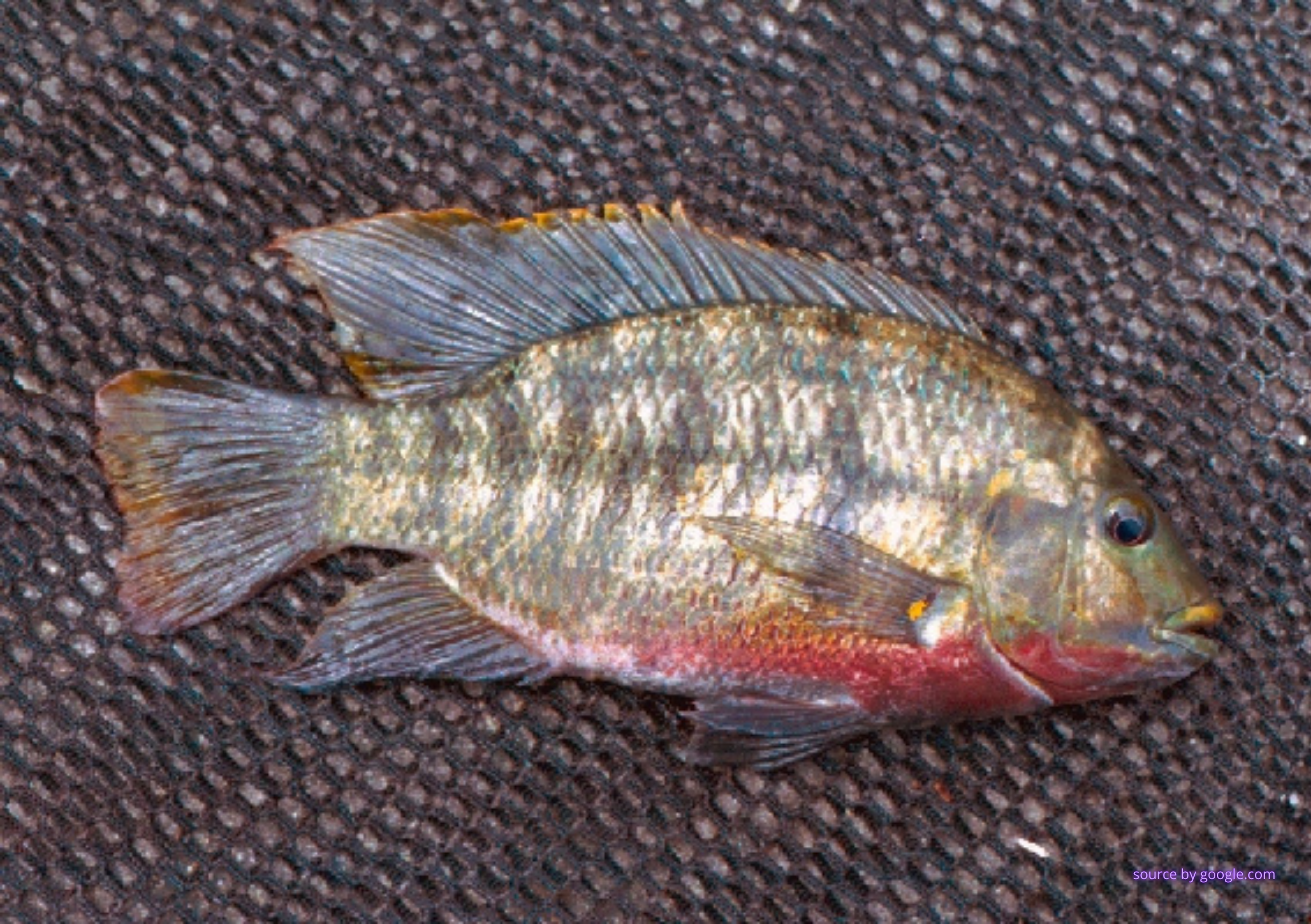Occurrence of Ectoparasites on Tilapia zillii (Red Belly Tilapia) Gervais 1848 in The Tono Reservoir, Navrongo, Ghana

Downloads
This study was carried out to assess the occurrence of endoparasites in (Tilapia zillii (Gervais, 1848)) from Tono reservoir, Navrongo Ghana. A total of 120 fish samples were collected from the upstream, midstream and downstream regions of the reservoir using cast nets. All the collected fish samples were transported to the research laboratory in the University for Development Studies and examined for ectoparasites during January 2022 to August 2022. Five ectoparasites namely Trichodina sp. of Protozoans ciliates, Dactyolgyrus sp. of Monogenean, Argulus sp. and Lernaea sp. of Crustaceans and the Diplostomum sp were identified. Overall prevalence of the fish parasites was 52.32 %. Intensity of the parasites observed ranged between 1.58% to 3.52%. Highest prevalence 70 % was reported in dry season while lowest (31.67%) was reported in the rainy season. Female fish samples had higher prevalence (64.47 %) than males (27.27 %). Fishes of downstream had highest prevalence (92.5 %) than upstream (17.5 %). Fish samples with maximum length and weight were highly (65.15 %) infected than small sized fish with low body length and weight (33.33 %). It is debatable if the degree of ectoparasite activity found in this study will constitute a serious danger to the local fish population. Yet, in order to stop disease outbreaks brought on by an increase in ectoparasites, the reservoir must be given significant attention by using optimum management strategies. This study shows that dry season affects the fish business and result in poor quality fish meat with risk of diseases infection.
Acosta-Pérez, V. J. et al. (2022) ‘Prevalence of Parasitic Infections with Zoonotic Potential in Tilapia: A Systematic Review and Meta-Analysis,’ Animals, 12(20), 2800. Available at: https://doi.org/10.3390/ani12202800.
Adams, S. et al. (2014) ‘Assessment of irrigation water quality of Tono Dam in Navrongo, Ghana,’ Journal of Biodiversity and Environmental Sciences, 4( 3), pp. 187-195.
Adesulu, E. A. (2008). Fishes, Under-water Hidden Treasures: An Inaugural Lecture Delivered at Oduduwa Hall, Obafemi Awolowo University, Ile-Ife on Tuesday, September 16, 2008 (Vol. 216). Obafemi Awolowo University Press.
Ahmad, I. et al. (2021) ‘Morphological, histopathological and molecular characterization of Myxobolus szekelyianus n. sp. (Cnidaria: Myxosporea: Myxobolidae) causing acute gill disease in Schizothorax esocinus (Heckel, 1838) from River Jhelum of Kashmir Himalayan region, India,’ Aquaculture Research, 52(12), pp. 6537-6549. Available at: https://doi.org/10.1111/are.15524
Akoll, P. et al. (2012) ‘Parasite fauna of farmed Nile tilapia (Oreochromis niloticus) and African catfish (Clarias gariepinus) in Uganda,’ Parasitology Research, 110, pp. 315-323, Available at: https://doi.org/10.1007/s00436-011-2491-4
Akongyuure, D. N. et al. (2017) ‘Tono Reservoir fishery contribution to poverty reduction among fishers in northern Ghana,’ African Journal of Aquatic Science, 42(2), pp. 143-154, Available at: https://doi.org/10.2989/16085914.2017.1344120
Alhassan, E. H. et al. (2018) ‘Ectoparasite infestation of Nile Tilapia (Oreochromis niloticus) in cage culture at Mpakadam, Ghana,’ Ethiopian Journal of Environmental Studies & Management, 11(5), pp. 514 – 525.
Ayaz, S. et al. (2013) ‘Prevalence of endoparasites in fresh water fishes in River Punjkorha, Khyber Pukhtunkhwa Pakistan,’ International Journal of Biology, Pharmacy and Allied Sciences, 2(1), 111-115.
Ayisi, C. L. et al. (2016) ‘Aquaculture extension services: A case study of fish farms in the eastern region of Ghana,’ International Journal of Fisheries and Aquatic Studies, 4(4), pp. 24-30.
Barker, D. E. and Cone, D. K. (2000) ‘Occurrence of Ergasilus celestis (Copepoda) and Pseudodactylogryrus anguillae (Monoge¬nea) among wild eels (Anguilla rostrata) in relation to stream flow, pH and temperature and recommendations for controlling their transmission among captive eels,’ Aquaculture, 187(3-4), pp. 261-274, Available at: https://doi.org/10.1016/S0044-8486(00)00324-0.
Bendryman, S. S., Grace, A. and Aksono, E.B. (2017) ‘Prevalence of Monogenean Helminth Ectoparasites on Catfish (Clarias gariepinus) Culture Ponds in Laban Village, Menganti District, Gresik Regency, East Java Province,’ Journal of Parasite Science, 1(1), pp. 33–38. Available at: https://doi.org/10.20473/jops.v1i1.16222.
Blahoua, G. K., Yao, S. S. and Nâ, V. (2016) ‘Distribution of gill Monogenean parasites from Oreochromis niloticus (Linn, 1758) in man-made Lake Ayam I, Cte dIvoire,’ African Journal of Agricultural Research, 11(2), pp. 117-129.
Buchmann, K. (2022) ‘Control of parasitic diseases in aquaculture,’ Parasitology, 149(14), pp.1985-1997, Available at: https://doi.org/10.1017%2FS0031182022001093
Bush, A. O. et al. (1997) ‘Parasitology meets ecology on its own terms: Margolis et al. revisited,’ The Journal of Parasitology, pp. 575-583.
FAO (2016). Fishery Country Profile: Republic of Ghana Fisheries and Aquaculture Sector Development Plan (2011-2016).
Ibrahim, S. M. (2009) ‘Evaluation of production and quality of salt-biscuits supplemented with fish protein concentrate,’ World Journal of Dairy and Food Sciences, 4(1), pp. 28-31.
Imran, M. et al. (2021) ‘Parasitic diseases of fish,’. Veterinary pathobiology & public health, pp. 203, Available at: https://doi.org/10.47278/book.vpph/2021.017.
Khan, W. et al. (2021) ‘Prevalence of rhabdochoniasis in snow trout of river Swat and river Panjkora, Khyber Pakhtunkhwa province, Pakistan,’ Brazilian Journal of Biology, 82, e238874.
López-Elías, J. A. et al. (2015) ‘Proximate composition of bioflocs in culture systems containing hybrid red tilapia fed diets with varying levels of vegetable meal inclusion,’ North American Journal of Aquaculture, 77(1), pp.102-109.
Mitiku, M. A. (2017). Parasite Species Richness of Fish from Fish Ponds and Fingerling Sources in Central Ethiopia: It’s Implication on Aquaculture Development (Doctoral dissertation, University of Natural Resources and Life Sciences), Available at: https://doi.org/10.23880/izab-16000314
Mitiku, M. A. and Adisu, D. (2021) ‘Review on parasites of commercially important tropical fishes: -Characteristics, Distribution, risk factors and Prevention approaches,’ Global Scientific Journal, 9(12), 1452-1465.
Ngodhe, O. A. S. (2021). Prevalence of parasitic infection in farmed nile tilapia, oreochromis niloticus (linnaeus, 1758) and other selected environmental factors associated with their transmission in winam gulf of lake victoria (Doctoral dissertation).
Ogonna, C. A., Emmanuel, I. N. and Michael, D. A. (2017) ‘Survey of ectoparasites of cultured fish from selected farms in Ebonyi State: potential for food and nutrient security,’ International Journal of Research in Pharmacy and Biosciences, 4(7), pp.1-6.
Omeji, S. et al. (2014) ‘Ecto and intestinal parasites of Malapterurus electricus from upper river benue,’ Journal of Global Biosciences, 3(6), pp. 895-903.
Pariselle, A. and Euzet, L. (2009) ‘Systematic revision of dactylogyridean parasites (Monogenea) from cichlid fishes in Africa, the Levant and Madagascar,’ Zoosystema, 31(4), pp. 849-898, Available at: https://doi.org/10.5252/z2009n4a6
Simon-Oke, I.A. (2017) ‘Diversity, intensity and prevalence of parasites of cichlids in polluted and unpolluted end of Eleyele Dam in Ibadan, Oyo State,’ UNED Research Journal, 9(1), pp. 45-50.
Suliman, E. A. M. and Al-Harbi, A. H. (2016) ‘Prevalence and seasonal variation of ectoparasites in cultured Nile tilapia Oreochromis niloticus in Saudi Arabia,’ Journal of Parasitic Diseases, 40, pp. 1487-1493, Available at: https://doi.org/10.1007%2Fs12639-015-0717-6.
Tombi, J., Akoumba, J. F. and Bilong Bilong, C. F. (2014) ‘The monogenean community on the gills of Oreochromis niloticus from Melen fish station in Yaounde, Cameroon,’ International Journal of Modern Biological Research, 2(2), pp. 16-23.
Copyright (c) 2024 Journal of Parasite Science (JoPS)

This work is licensed under a Creative Commons Attribution-NonCommercial-ShareAlike 4.0 International License.
- Every manuscript submitted to must observe the policy and terms set by the Journal of Parasite Science
- Publication rights to manuscript content published by the Journal of Parasite Science is owned by the Journal of Parasite Science with the consent and approval of the author(s) concerned
- Authors and other parties are bound to the Creative Commons Attribution-NonCommercial-ShareAlike 4.0 International License for the published articles, legal formal aspect of journal publication accessibility refers to Creative Commons Attribution-NonCommercial-ShareAlike 4.0 International License (CC BY-NC-SA)
- By submitting the manuscript, the author agrees to the requirement that the copyright of the submitted article will be transferred to Journal of Parasite Science as the publisher of the journal. The intended copyright includes the right to publish articles in various forms (including reprints). journal of parasite science retains the publishing rights to published articles.

































